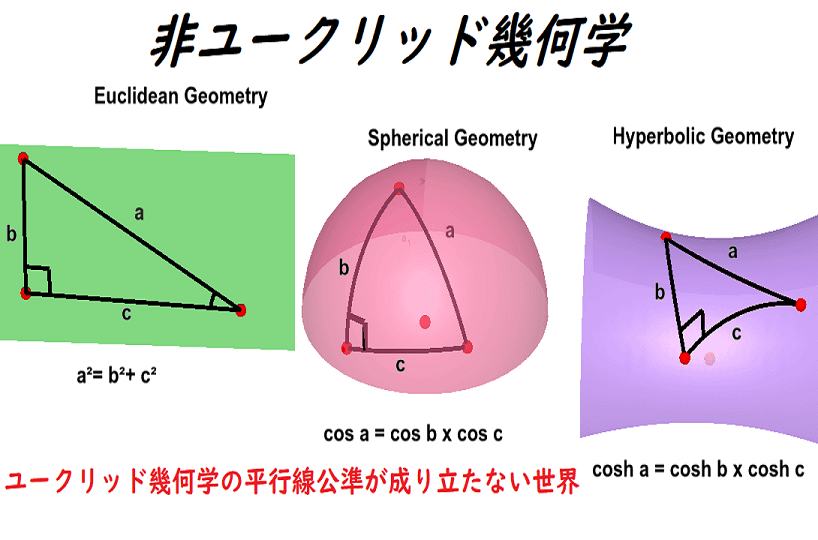優等生試験の後,大学での次の学究上のステップは、給費研究員資格請求学位論文(a Fellowship dissertation)を執筆することであった。私は学位論文の主題として「幾何学の基礎」を選び、非ユークリッド幾何学がカントの超越論的芸術哲学(transcendental aesthetic 超越論的美学)に及ぼす影響について特に注意を払った。この学位論文の執筆作業は(work)は、経済学及びドイツ社会主義に関する執筆作業(work 研究活動)-- の間に点在させられており(散りばめられており)、それはベルリンに二冬(ふたふゆ)を本拠地を置いて(based upon)、私の最初の著作(公刊したもの)の主題となった。ベルリンでのこの二冬、それから、その翌年(1896年)に妻と一緒のアメリカ旅行は、ケンブリッジ(大学)の偏狭さ(parochialism 地方根性)を治すのに大いに役立ち、また、私がそれ以前に聞いたことのなかったドイツ人の純粋数学に関する著作(及び研究)に気づかせた。それ以前の誓い(注:もう数学の本なんて読まない!という誓い)にもかかわらず、(誓いの後)私は大量の数学書を読んでいた。その多くは、後にわかったことであるが、私の主要な目的には全く無関係なものであった。私はダルブーの『曲面論』(Theory of Surfaces)やディニの『実変数関数論』(Theory of Functions of a Real Variable)や、フランス人の著になる数種の『解析概論』(Cours d’Analyse)や、ガウスの『一般曲面論』(General Theory of Curved Surfaces)やグラスマンの『線形延長論延長論』(Ausdehnungslehre)を読んだ。このグラスマンの本は,ホワイトヘッドによって導かれたものである。ホワイトヘッドの『普遍的代数論』(Universal Algebra)は私を大いに興奮させたが、その本はその後(ラッセル夫妻訪米時以後)すぐに出版されており(注:『普遍的代数論』は1898年に出版)、グラスマンの体系に大いに関連していた。けれども,私は、応用数学の方が純粋数学よりも価値のある研究であると(当時)信じていた。なぜなら,応用数学の方が --私はヴィクトリア王朝時代の楽観主義でそう考えていたのだが-- 人間の幸福をより増進しそうだからであった。私はクラーク・マックスウェル(著)『電気と磁気』を注意深く読み、ヘルツの『力学原理』を研究し、ヘルツが電磁波を作り出すことに成功したときは大いに喜んだ。J. J. トムソンの実験的研究は、大いに私の興味をひいた。私はまた、自分の目的により関連することが(後で)わかった著作、たとえば、デデキントやカントールやフレーゲの著作 --(学位論文執筆において)私のより助けになった可能性があったが-- は後になって(学位論文執筆後に)知ったのである。
Chapter 4: Excursion into Idealism, n.3
After the Tripos, the next academic step was the writing of a Fellowship dissertation. I chose for my subject ‘The Foundations of Geometry’ , and paid special attention to the effect of non-Euclidean geometry on Kant’s transcendental aesthetic. My work on this dissertation was interspersed with work on economics and on German social democracy, which was the subject of my first book, based upon two winters in Berlin. These two winters, and a journey to America with my wife in the following year (1896), did much to cure me of Cambridge parochialism, and made me aware of German work in pure mathematics which I had not previously heard of. In spite of my earlier vow, I read a very great deal of mathematics – much of it, as I afterwards discovered, quite irrelevant to my main purpose. I read Darboux’s Theory of Surfaces, Dini’s Theory of Functions of a Real Variable, and several French Cours d’Analyse, Gauss’s General Theory of Curved Surfaces, and Grassman’s Ausdehnungslehre, to which I was led by Whitehead, whose Universal Algebra, which greatly excited me, was published shortly after this time and was largely concerned with Grassman’s system. I was, however, persuaded that applied mathematics is a worthier study than pure mathematics, because applied mathematics – so, in my Victorian optimism, I supposed – was more likely to further human welfare. I read Clerk Maxwell’s Electricity and Magnetism carefully, I studied Hertz’s Principles of Mechanics, and I was delighted when Hertz succeeded in manufacturing electro-magnetic waves. J. J. Thompson’s experimental work interested me greatly. I read, also, works that proved more relevant to my purpose, such as those of Dedekind and Cantor, Frege, who might have helped me more, I did not know of until later.
Source: My Philosophical Development, chap. 4,1959.
More info.:https://russell-j.com/beginner/BR_MPD_04-030.HTM

